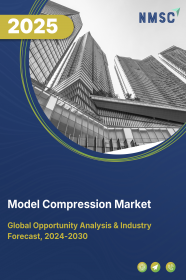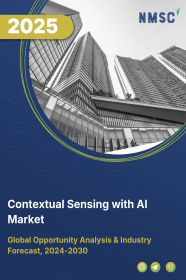
Model Compression Market by Compression Technique (Pruning, Quantization, Knowledge Distillation, and Weight Sharing), by Deployment Model (Cloud-Based, On-Premises Solutions, and Edge Computing), and by Industry Verticals (Healthcare, Retail, Automotive, Telecommunications, and Others)– Global Opportunity Analysis and Industry Forecast, 2024-2030
US Tariff Impact on Model Compression Market
Trump Tariffs Are Reshaping Global Business
Model Compression Market Overview
The global Model Compression Market size was valued at USD 1.01 billion in 2023 and is predicted to reach USD 1.63 billion by 2030 with a CAGR of 7.1% from 2024 to 2030
Model compression market, also known as model reduction market, encompasses technologies and solutions aimed at reducing the size and complexity of machine learning models while maintaining their accuracy and performance. This process includes techniques such as pruning, quantization, knowledge distillation, and low-rank factorization, that optimize models for deployment in resource-constrained environments, such as mobile devices, edge computing, and IoT systems.
These techniques allow AI models to run efficiently on resource-constrained devices such as smartphones, IoT devices, and edge computing platforms. Its benefits include faster inference, reduced energy consumption, and lower memory usage, making AI more accessible on devices with limited resources. Overall, compression model enables the widespread deployment of AI in diverse industries by balancing performance with resource efficiency.
Market Dynamics and Trends
The rising demand for edge computing propels the need for model compression as more AI models are being deployed on resource-constrained devices such as smartphones, IoT devices, and autonomous systems. Edge computing involves processing data closer to the local devices rather than relying on centralized cloud servers, that requires models that are smaller, faster, and energy-efficient.
According to the latest report published by the PWC, the global edge computing market reached around USD 36.5 billion in 2021 and is anticipated to surge to USD 87.3 billion by 2026. The growing demand for edge computing drives the need for optimized, compressed models to ensure AI applications run efficiently on edge devices with limited memory, power, and energy, thereby boosting market growth.
Furthermore, the increasing global demand for electric vehicles (EVs) is increasing the need for model compression as EVs become more reliant on advanced AI-driven systems for battery management, autonomous driving, energy optimization, and real-time diagnostics. As per the report published by the International Energy agency, global electric car sales reached around 14 million in 2023. The rapid growth of the EV industry increases the demand for model reduction to maintain optimal performance without straining the vehicle's battery or computational resources.
Moreover, the surge in healthcare spending is driving the market growth as the industry increasingly adopts AI and machine learning technologies to enhance patient care, streamline operations, and improve diagnostic accuracy. With the rising demand for telemedicine, personalized medicine, and advanced medical imaging solutions, healthcare providers require efficient AI models that run on various devices, where computational resources are limited.
The latest report of the World Economic forum 2024 states that the global healthcare spending reached USD 9.8 trillion, contributing to 10.3% of the total GDP in 2021. As healthcare sector continues to invest in technology to improve patient outcomes and operational efficiency, the need for optimized, resource-efficient AI solutions grows, further propelling the market growth.
However, data sensitivity hinders model compression industry growth as reductions in performance result in critical errors that undermine trust. Consequently, organizations hesitate to adopt these models, fearing inaccuracies would compromise patient safety or financial integrity.
On the other hand, the integration of quantum computing in model compression is expected to create significant opportunities for the market growth in the forthcoming years by enabling faster and more efficient algorithms for processing and compressing large datasets. This advancement creates new growth opportunities for the model reduction market as industries adopt quantum-powered solutions to enhance AI performance across various applications.
Market Segmentations and Scope of the Study
The model compression market report is segmented on the basis of compression technique, deployment model, industry verticals, and region. On the basis of product type, the market is divided into pruning, quantization, knowledge distillation, and weight sharing. On the basis of deployment model, the market is classified into cloud-based, on-premises solutions, and edge computing.
On the basis of industry vertical, the market is segmented into healthcare, retail, automotive, telecommunications, and others. Regional breakdown and analysis of each of the aforesaid segments include regions comprising North America, Europe, Asia-Pacific, and RoW.
Geographical Analysis
North America holds the dominant in model compression market share and is projected to maintain its dominance throughout the forecast period. This is attributed to the rise in healthcare spending in countries such as the U.S. and Canada that significantly increases the demand for advanced AI and machine learning technologies for improved patient outcomes and operational efficiency.
According to the report of the American Medical Association 2024, the healthcare spending in the U.S. rose to USD 4.5 trillion or USD 13,493 per capita in 2023. With such expansion of the healthcare sector in the country, the demand for scalable and efficient AI solutions that can operate effectively and meet regulatory requirements is on the rise, boosting the model compression market growth.
Additionally, the surge in growth of the telecom industry in the region boosts the need to manage the increasing data traffic and improve network efficiency with advanced AI-driven analytics that in turn boosts the market growth. As per the report published by the Canadian Telecommunications Association in 2024, Canadian telecommunication sector contributed around USD 58.92 billion towards Canadian economy in 2024. Such expansion of the telecom sector in the region fuels the market growth to enhance network efficiency and deliver seamless connectivity.
On the other hand, the Asia-Pacific region is expected to show a steady rise in the model compression industry growth due to the growth of the retail industry in the countries such as India and China. With the rise of e-commerce and omnichannel strategies, retailers are generating vast amounts of data that in turn boosts the adoption of model compression technology.
According to the report of the India Brand Equity in 2024, India is ranked as the fifth largest retail space globally and contributes to around 10% of the GDP of the country in 2023. As retail sector of the region expands, the adoption of model compression becomes crucial for implementing scalable, efficient AI solutions across the retail sector.
Moreover, the surge in demand for EVs in the region increases the need to enhance the efficiency of AI applications used in various vehicle functions, such as battery management, autonomous driving, and driver assistance systems that in turn boosts the market growth. According to the latest report of the International Energy Agency, the number of electric car registration increased by 35% in 2023, reaching around 8.1 million. Consequently, the growth of the EV market fosters greater adoption of model compression techniques to meet the model compression market demands of this evolving sector.
Competitive Landscape
Various key players operating in the model compression industry includes SAP SE, Microsoft Corporation , Intel Corporation, Amazon Web Services, Inc. , Qualcomm Incorporated , Oki Electric Industry Co., Ltd., Apple Inc., Actuarial Resources Corporation, Neuralmagic, Inc., NVIDIA Corporation and others. These market players are adopting strategies such as acquisition to stay competitive and maintain their market positions.
For instance, in August 2024, Amazon acquired Perceive, a company focused on edge chip technology and AI model compression, for USD 80 million to strengthen its capabilities in edge computing. This acquisition highlights the growing importance of model reduction in optimizing AI performance for edge applications.
Key Benefits
-
The report provides quantitative analysis and estimations of the model compression market from 2024 to 2030, which assists in identifying the prevailing market opportunities.
-
The study comprises a deep dive analysis of the current and future model compression market trends to depict prevalent investment pockets in the industry.
-
Information related to key drivers, restraints, and opportunities and their impact on the model compression market is provided in the report.
-
Competitive analysis of the players, along with their market share is provided in the report.
-
SWOT analysis and Porters Five Forces model is elaborated in the study.
-
Value chain analysis in the market study provides a clear picture of roles of stakeholders.
Model Compression Market Key Segments
By Compression Technique
-
Pruning
-
Quantization
-
Knowledge Distillation
-
Weight Sharing
By Deployment Model
-
Cloud-Based
-
On-Premises Solutions
-
Edge Computing
By Industry Vertical
-
Healthcare
-
Retail
-
Automotive
-
IT& Telecommunications
-
Others
By Region
-
North America
-
The U.S.
-
Canada
-
Mexico
-
-
Europe
-
The UK
-
Germany
-
France
-
Italy
-
Spain
-
Denmark
-
Netherlands
-
Finland
-
Sweden
-
Norway
-
Russia
-
Rest of Europe
-
-
Asia Pacific
-
China
-
Japan
-
India
-
South Korea
-
Australia
-
Indonesia
-
Singapore
-
Taiwan
-
Thailand
-
Rest of Asia Pacific
-
-
RoW
-
Latin America
-
Middle East
-
Africa
-
Key Players
-
SAP SE
-
Microsoft Corporation
-
Intel Corporation
-
Amazon Web Services, Inc.
-
Qualcomm Incorporated
-
Oki Electric Industry Co., Ltd.
-
Apple Inc.
-
Actuarial Resources Corporation
-
Neuralmagic, Inc.
-
NVIDIA Corporation
REPORT SCOPE AND SEGMENTATION
|
Parameters |
Details |
|
Market Size in 2023 |
USD 1.01 Billion |
|
Revenue Forecast in 2030 |
USD 1.63 Billion |
|
Growth Rate |
CAGR of 7.1% from 2024 to 2030 |
|
Analysis Period |
2023–2030 |
|
Base Year Considered |
2023 |
|
Forecast Period |
2024–2030 |
|
Market Size Estimation |
Billion (USD) |
|
Growth Factors |
|
|
Countries Covered |
28 |
|
Companies Profiled |
10 |
|
Market Share |
Available for 10 companies |
|
Customization Scope |
Free customization (equivalent up to 80 working hours of analysts) after purchase. Addition or alteration to country, regional, and segment scope. |
|
Pricing and Purchase Options |
Avail customized purchase options to meet your exact research needs. |

















 Speak to Our Analyst
Speak to Our Analyst





















